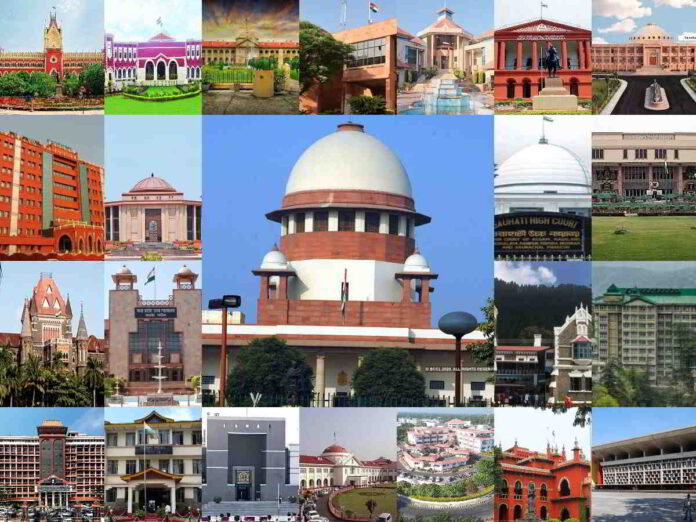The Supreme Court of India is the temple of Justice. It is the supreme body and highest court of law in the country.
Judiciary is one of the organs of the Government, and the Apex Court takes on the job of leading this organ. It has always put forward the best efforts for providing a single integrated system of Courts to administer both Union and State laws.
To conduct its activities, the Supreme Court has certain conduct, organisation and constitution. Such is the importance with the Supreme Court Collegium.

What is the Supreme Court Collegium?
Collegium is defined as a group in which each member has approximately equal power and authority. The Supreme Court Collegium started back in 1998 and is a group of 5 senior-most Judges of the court. This means, the Chief Justice of India, and four senior-most judges of the court.
At present (2021), the collegium consists of:
- Chief Justice of India N.V. Ramana,
- Justice Rohinton Fali Nariman,
- Justice Uday Umesh Lalit,
- Justice Ajay Manikrao Khanwilkar and
- Justice Dhananjaya Yeshwant Chandrachud.
The collegium system operates to appoint and transfer judges in High Courts and Supreme Court. For instance, it elevates judges of High Courts throughout the country to Chief Justices of High Courts, elevating judges to Supreme Court etc.
The forum takes decisions collectively. In case of differences in opinion, whatever the majority opinion is, will prevail. The Constitution of India makes it compulsory to consult the Chief Justice of India for appointments to judiciary, and thus, the collegium model kept evolving.
History of the Collegium:
Under the Constitution, the appointment of judges is described under Art.124 and Art.217 for Supreme Court and High Courts respectively. However, neither of them mention the term “Collegium”.
It was years after Independence that the Apex court devised its own method of appointment. Traditionally, the senior-most judge of the Supreme Court would be appointed as the CJI. The President would consult the CJI or any other judges they may deem necessary for appointing Supreme Court Judges, and as for the High Courts, additional consultations with Governor and High Court Judges can be done.
However, in 1973, a junior judge was appointed as the CJI, due to which three senior-most judges resigned from their posts. It was alleged that the Government tried to play favourites.
It is from here that controversies over the appointment of judges started. After this, there were three cases relating to the appointment of judges; the concept of which came to be known as the “three judges cases”. This is immediately related to the collegium.
The three judges’ cases were three cases related to the appointment of judges to courts. These are:
- S P Gupta Vs. Union of India And Ors. [AIR 1982 SC 149]
- Supreme Court Advocates on Record Association Vs. Union of India [(1993) 4 SCC 441]
- In Re Special Reference Case [AIR 1999 SC 1]
It was during the second case that the Collegium system was formed. It was in the third case that the number of members in the Collegium was decided. Over the course of these cases, the court evolved the principle of judicial independence so that no other branch of the state would be included in the appointment of judges. During this, the collegium system came into being.
How does the Collegium Work?
The Constitution states that the appointment of Judges should be made by the President after consultation with judges as necessary. Except for their own appointment, the CJI must be there at all consultations. In dealing with the appointment of High Court judges, they should be appointed by the President after consultation with the CJI and the Governor of the concerned state. The Chief Justice of the High Court concerned too should be consulted.
Thus, the Collegium sends its recommendations to the Central Government. Just like that, the central government also sends their recommendations to the Collegium. The Collegium then reviews these recommendations and sends the final recommendation to the Center. However, if the collegium sends the same name twice, the center just has to kind of accept it. The downside to this working is that there is no fixed time to reply to recommendations and thus, the appointment of judges takes a long time.
Arguments against the collegium system:
The Collegium has added an administrative burden on the Judiciary of appointing and transferring judges without a separate mechanism for collecting and checking backgrounds of prospective appointments. It appears to be a closed, informal and transparent system.
Another limitation is the choice of the Collegium. It is usually always that the senior-most judges are preferred for appointments, thus overlooking several other talented persons.
Supreme Court’s guidelines on Appointments:
Although the Constitution does not mention the Collegium, the Collegium in itself keeps up with acting in a constitutional way. For instance, under Articles 124 (2), 217(1) and 222 (1), the opinion of the CJI is to be formed via consultation with other Judges. Thus, in the working of the Collegium, an individual opinion of the CJI would not stand as an opinion of the Collegium.
According to the Constitution, the Judges have to be appointed by the President. Thus, the CJI can only make a recommendation to appoint a judge of the Supreme Court as a Chief Justice. Even for judges of a High Court, only in consultation with the other members of the Collegium can the decision be made. Concerning High Courts, the recommendations must be made with at least the two senior-most judges of the Collegium.
Also read
While making the recommendations, the positive reasons for recommendations must be recorded. However, if the Collegium departs from recommending the senior-most judge, no justification is required. The reasons should be given in writing and should be conveyed to the Center by the CJI. Recommendations however, are not binding upon the government.
The decisions regarding appointments in High Court are only judicially reviewable only if the decision was reached upon without consultation from other Collegium members and Chief Justices of the said High Court.
The CJI cannot act in his individual capacity, without consultation with other members of the Collegium, in events of non-appointment of judges by the government after looking at the materials and information of the candidate.
Suggested alternatives to the Collegium:
A proposal for alternatives remains to be a National Judicial Commission. In 2003, the Constitution (98th Amendment) Bill was brought to the Lok Sabha which provided for the constitution of the National Judicial Committee. It would be chaired by the CJI along with two senior-most judges as members. Along with that, the Union Law Minister would also be a member. A unique point of membership suggested was also the appointment of an eminent citizen; who was to be nominated by the President and Prime Minister. It would be this Commission that would decide the appointment and transfer of judges and probe cases of misconduct.
Edited by
Rajat Rajan Singh
Editor in Chief at Law Trend
Advocate- Allahabad High Court at Lucknow
Written by-
Sai Kulkarni- Intern







